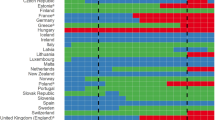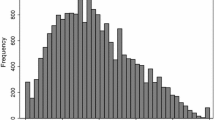Abstract
The use of Diagnosis Related Groups (DRG) as a mechanism for hospital financing is a currently debated topic in Portugal. The DRG system was scheduled to be initiated by the Health Ministry of Portugal on January 1, 1990 as an instrument for the allocation of public hospital budgets funded by the National Health Service (NHS), and as a method of payment for other third party payers (e.g., Public Employees (ADSE), private insurers, etc.). Based on experience from other countries such as the United States, it was expected that implementation of this system would result in more efficient hospital resource utilisation and a more equitable distribution of hospital budgets. However, in order to minimise the potentially adverse financial impact on hospitals, the Portuguese Health Ministry decided to gradually phase in the use of the DRG system for budget allocation by using blended hospital‐specific and national DRG case‐mix rates. Since implementation in 1990, the percentage of each hospital’s budget based on hospital specific costs was to decrease, while the percentage based on DRG case‐mix was to increase. This was scheduled to continue until 1995 when the plan called for allocating yearly budgets on a 50% national and 50% hospital‐specific cost basis. While all other non‐NHS third party payers are currently paying based on DRGs, the adoption of DRG case‐mix as a National Health Service budget setting tool has been slower than anticipated. There is now some argument in both the political and academic communities as to the appropriateness of DRGs as a budget setting criterion as well as to their impact on hospital efficiency in Portugal. This paper uses a two‐stage procedure to assess the impact of actual DRG payment on the productivity (through its components, i.e., technological change and technical efficiency change) of diagnostic technology in Portuguese hospitals during the years 1992–1994, using both parametric and non‐parametric frontier models. We find evidence that the DRG payment system does appear to have had a positive impact on productivity and technical efficiency of some commonly employed diagnostic technologies in Portugal during this time span.
Similar content being viewed by others
References
D.J. Aigner and S.-F. Chu, On estimating the industry production function, American Economic Review 58(4) (1968) 259–269.
D.J. Aigner, C.A.K. Lovell and P. Schmidt, Formulation and estimation of stochastic frontier production function models, J. Econometrics 6(1) (1977) 21–37.
G.E. Battese and T.J. Coelli, Frontier production functions, technical efficiency and panel data: with application to paddy farmers in India, J. Productivity Analysis 3 (1992) 153–169.
P.W. Bauer, A.N. Berger and D.B. Humphrey, Efficiency and productivity growth in US banking, in: The Measurement of Productive Efficiency, eds. H.O. Fried, C.A. Lovell and S.S. Schmidt (OUP, 1993).
M. Bentes, M.C. Mateus and M.L. Gonsalves, DRGs in Portugal: a decade of experience, in: 8th Casemix Conference, Casemix and Change. International Perspectives, 16–18 September 1996, Sidney, Australia (1996).
A. Charnes, W.W. Cooper and E. Rhodes, Measuring the efficiency of decision-making units, European J. Oper. Res. 11(1) (1978) 429–444.
S. Chattopadhyay and S.C. Ray, Technical, scale, and size efficiency in nursing home care: a nonparametric analysis of Connecticut homes, Health Economics 5(4) (1996) 363–373.
T. Coelli, A guide to frontier version 4.1: a computer program for stochastic frontier production and cost function estimation, CEPA Working Paper, 96/07 (1996).
C. Costa, Os DRGs (diagnostic related groups) e a gestão do hospital, Revista Portuguesa de Gestão 3/4 (1994) 47–65.
R.F Coulam and G.L. Gaumer, Medicare's prospective payment system: a critical appraisal, Health Care Financing Review, Annual Supplement (1991).
C.E. Dismuke, A preliminary analysis of the DRG system in Portugal: hospital response as measured by length of stay, Universidade do Minho, Portugal (1995), unpublished paper.
C.E. Dismuke, Has the DRG system really influenced hospital ef-ficiency in Portugal?, Universidade do Minho, Portugal (1996), unpublished paper.
C.E. Dismuke and P. Guimarães, An application of a count model to analysing hospital mortality rate variability, Presented at 6th European Workshop on Econometrics and Health Economics, 10–13 September, 1997.
R.P. Ellis and T.G. McGuire, Hospital response to prospective payment: moral hazard, selection and practice-style effects, J. Health Economics 15 (1996) 257–277.
R. Färe et al., Productivity changes in Swedish pharmacies 1980–1989: a nonparametric Malmquist approach, J. Productivity Analysis 3(1/2) (1992) 85–101.
M.J. Farrell, The measurement of productive efficiency, J. Royal Statist. Soc. ACXX Part 3 (1957) 253–290.
F. Fecher and P. Pestieu, Efficiency and competition in OECD fi-nancial services in: The Measurement of Productive Efficiency, eds. H.O. Fried, C.A.K. Lovell and S.S. Schmidt (OUP, 1993).
R.B. Fetter, ed., DRGs: Their Design and Development (Health Administration Press, Ann Arbor, MI, 1991).
F. Forsund, Productivity growth in Norwegian Ferries, in: The Measurement of Productive Efficiency, eds. H.O. Fried, C.A.K. Lovell and S.S. Schmidt (OUP, 1993).
H.O. Fried, C.A.K. Lovell and S.S. Schmidt, eds., The Measurement of Productive Efficiency (OUP, 1993).
B.H. Gilman, Hospital response to DRG refinements: the impact of multiple reimbursement incentives on length of stay, Department of Economics, Boston University (1997), unpublished paper.
W.H. Greene, Econometric Analysis, 3rd ed. (Prentice-Hall, NJ, 1997).
S. Guterman and A. Dobson, Impact of the medicare prospective payment system for hospitals, Health Care Financing Review 7 (1986) 97–114.
D. Hodgkin and T.G. McGuire, Payment levels and hospital response to prospective payment, J. Health Economics 13 (1994) 1–29.
K.P. Kalirajan and R.T. Shand, Testing causality between technical and allocative efficiencies, Working Paper no. 88/6 Research School of Pacific Studies, Australian National University, Canberra, Australia (1988).
T.C. Koopmans, An analysis of production as an efficient combination of activities, in: Activity Analysis of Production and Allocation, ed. T.C. Koopmans (Wiley, New York, 1951).
P. Kooreman, Nursing home care in the Netherlands: a nonparametric efficiency analysis, J. Health Economics 13 (1994) 301–316.
K. Luoma et al., Financial incentives and productive efficiency in Finnish health centres, Health Economics 5(5) (1996) 435–445.
J. Magnussen, Efficiency measurement and the operationalization of hospital production, Health Services Research 31(1) (1996) 21–37.
J.P. Newhouse, Frontier estimation: how useful a tool for health economics?, J. Health Economics 13 (1994) 317–322.
C.W. Price and T.G. Weyman-Jones, Malmquist indices of productivity change in the UK gas industry before and after privatisation, Applied Economics 28(1) (1996) 29–39.
M.D. Rosko and R.W. Broyles, Short-term responses of hospitals to the DRG prospective pricing mechanism in New Jersey, Medical Care 25 (1987) 88–99.
B. Russell, Medicare's New Hospital Payment System. Is it Working? (Brookings Institution, Washington, DC, 1989).
V. Sena, The Determinants of Technical Efficiency in the Italian District Hospitals, University of York, Discussion Paper Series, 8/98 (1998).
F.A. Sloan, J. Valvona and R. Mullner, Medicare prospective payment and the use of medical technologies in hospitals, Medical Care 26 837–853.
Proc. 8th Casemix Conference, Casemix and Change. International Perspectives, 16–18 September 1996, Sidney, Australia (1996).
D.F. Vitaliano and M. Toren, Cost efficiency in nursing homes: a stochastic frontier approach, J. Health Economics 13 (1994) 281–300.
S. Zuckerman et al., Measuring hospital efficiency with frontier cost functions, J. Health Economics 13 (1994) 255–280.
Author information
Authors and Affiliations
Corresponding author
Rights and permissions
About this article
Cite this article
Dismuke, C.E., Sena, V. Has DRG payment influenced the technical efficiency and productivity of diagnostic technologies in Portuguese public hospitals? An empirical analysis using parametric and non‐parametric methods. Health Care Management Science 2, 107–116 (1999). https://doi.org/10.1023/A:1019027509833
Issue Date:
DOI: https://doi.org/10.1023/A:1019027509833




